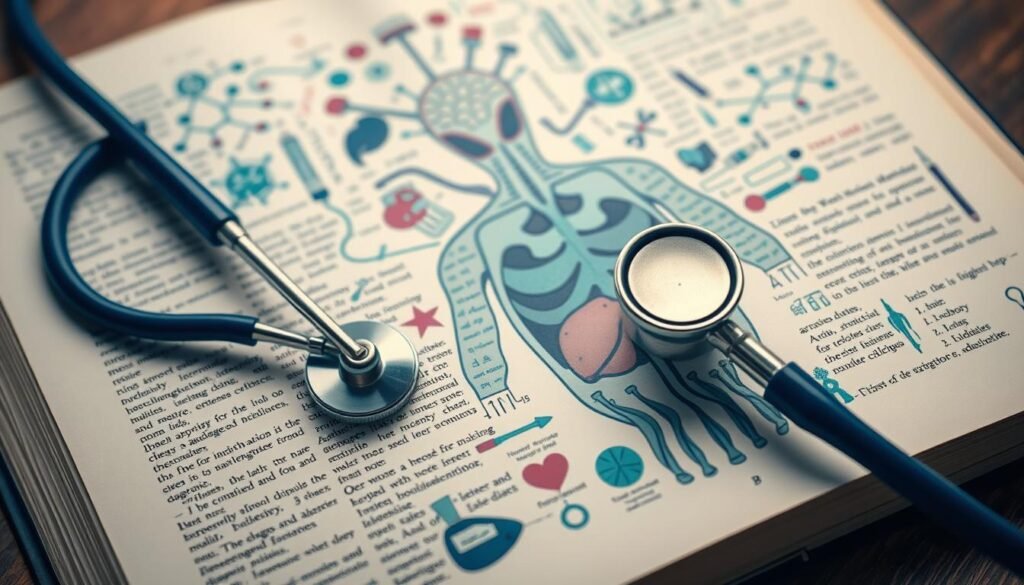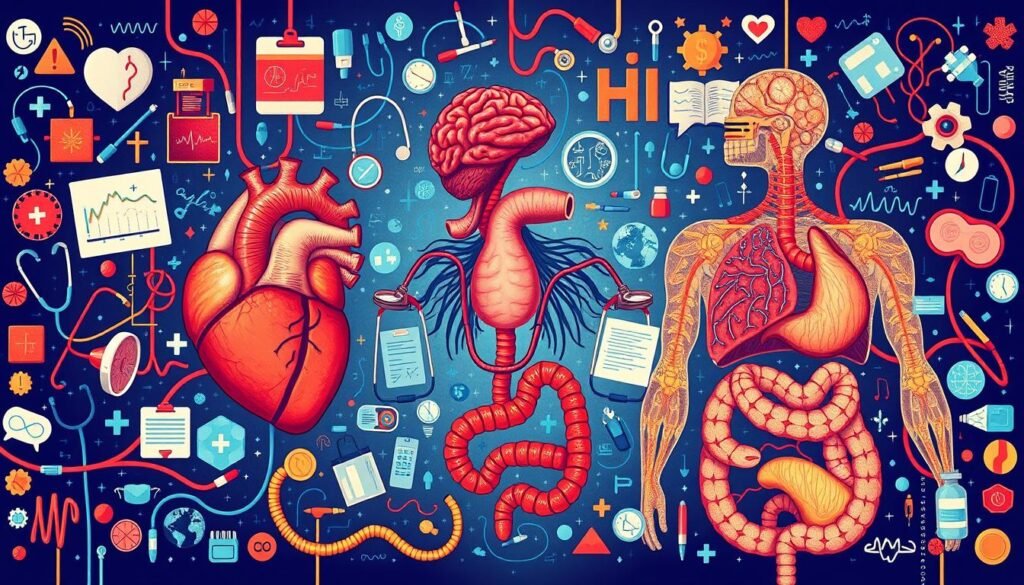Learning medical terminology is key for healthcare workers. It helps them talk clearly with patients, make accurate diagnoses, and document well. By learning medical terms, you can understand the body better and the many health issues and treatments.
If you’re in medical school or a doctor wanting to learn more, this guide is for you. It will teach you how to understand prefixes, roots, and suffixes. You’ll learn to use this knowledge in real medical situations. This will help you talk confidently with patients, give better care, and help the healthcare field grow.
Key Takeaways
- Learn the basics of medical terms, like prefixes, roots, and suffixes, to start well in medical terminology.
- Get to know common medical terms and their meanings. This includes many body systems, health issues, and treatments.
- Find ways to remember and use medical terms in different healthcare situations. This includes talking to patients, writing medical notes, and working with other doctors.
- Discover the unique terms used in different medical areas. This will help you understand the healthcare system better.
- Keep up with new medical terms and ideas. This will keep your knowledge current and useful.
Understanding the Basics of Medical Terminology
To navigate the complex world of medical terms, it’s key to know the basics. This includes prefixes, roots, and suffixes. These parts help build terms that describe body systems, structures, and conditions.
Also Read : How To Identify Symptoms Of An Underlying Medical Condition
Prefixes, Roots, and Suffixes
Prefixes are the start of a term and add context or change its meaning. Examples are “anti-” (against), “hyper-” (excessive), and “pre-” (before). Roots are the core and often show a body part or condition. For instance, “cardi-” (heart) and “hepat-” (liver).
Suffixes are at the end and show the procedure, condition, or specialty. They include “-itis” (inflammation) and “-ology” (the study of).
Knowing these parts helps students and professionals understand and use medical terms. This skill is vital for clear communication in healthcare.
| Word Part | Meaning | Examples |
|---|---|---|
| Prefix | Modifies the meaning of the root | Anti- (against), Hyper- (excessive), Pre- (before) |
| Root | Represents a specific body part or condition | Cardi- (heart), Hepat- (liver) |
| Suffix | Indicates the procedure, condition, or specialty | -itis (inflammation), -ology (the study of) |
Learning the basics of medical terminology is essential. By knowing prefixes, roots, and suffixes, you can understand complex terms. This skill is crucial for effective communication in healthcare.
Also Read : Medical Gloves: How They Protect Patients and Healthcare Workers
Mastering Medical Term

Learning medical terminology is key for students and healthcare workers. It’s vital for those studying to be healthcare providers or to talk clearly in medical settings. But, how do you really master these terms?
Using memorization techniques is a good start. Linking medical roots, prefixes, and suffixes to their meanings helps you learn fast. Also, context-based learning is helpful. It means practicing with real-life scenarios to better understand and use terms.
Also Read :Medical License Requirements: What You Need To Know For Different Countries
Adding practice exercises to your study plan is smart. Quizzes, flashcards, and interactive games help you remember medical words. This makes them stick in your memory.
But, it’s not just about memorizing. It’s also about getting to know the language of medicine deeply. Read medical journals, textbooks, and talk to healthcare pros. This way, you learn how terms are used in real life.
Mastering medical terms is about smart learning, regular practice, and being curious. By using these methods, you’ll become a confident and skilled medical communicator.
“The more you know, the more you grow. Mastering medical terminology is a journey, not a destination.”
Exploring Medical Specialties and Body Systems

Learning medical terminology is key for students and healthcare workers. It helps them understand different medical fields and body systems. By knowing prefixes, roots, and suffixes, they can better grasp anatomy, physiology, and medical conditions.
Also Read : A Complete Guide To Medical Vs Medicare: What You Need To Know
The cardiovascular system is a major focus. It includes the heart, blood vessels, and how blood circulates. Terms like “cardi-” (heart) and “vascular” (blood vessels) are used. For instance, “cardiology” is the study of the heart, and “hypertension” means high blood pressure.
The respiratory system is also important. It deals with gas exchange in the body. Terms like “pneum-” (lung) and “pnea” (breathing) are used. For example, “pneumonia” is lung inflammation, and “dyspnea” is trouble breathing.
| Medical Specialty | Relevant Body System | Example Terminology |
|---|---|---|
| Cardiology | Cardiovascular | Cardio-, Vascular-, Hypertension, Arrhythmia |
| Pulmonology | Respiratory | Pneum-, Pnea, Dyspnea, Bronchitis |
| Gastroenterology | Digestive | Gastro-, Entero-, Ulcer, Diarrhea |
| Urology | Urinary | Uro-, Nephr-, Cyst-, Incontinence |
| Orthopedics | Musculoskeletal | Osteo-, Arthr-, Myalgia, Fracture |
| Neurology | Nervous System | Neuro-, Encephal-, Neuropathy, Stroke |
This table shows how medical specialties and body systems are connected. It also gives examples of specific terms used in each field. By exploring these connections, students and practitioners can gain a deeper understanding of medical language and its application in healthcare.
Applying Medical Terminology in Practice

Case Studies and Real-World Examples
Also Read : Medical Emergency Kit For Families: What You Need For Every Situation
Learning medical terminology is more than just memorizing words. It’s about using those terms in real-life situations to improve patient care and teamwork in healthcare. By looking at case studies and real examples, students and professionals can understand how medical terms are used every day.
Imagine a patient with dyspnea (trouble breathing) and chest pain. The doctor must write down the patient’s main problem, do a full check-up, and order tests like an electrocardiogram (ECG) and chest X-ray. Using the right medical terms in the patient’s file helps everyone understand the situation and plan the best treatment.
Another key point is how important it is to document medical information clearly. For example, if a patient has hypertension (high blood pressure), the doctor must share this information, any other health issues, and the treatment plan with the whole healthcare team. This clear communication helps everyone work together better and improves patient care.
| Metric | Value |
|---|---|
| Annual full pay range for the position | $50,321 – $62,640 (prorated if appointment percentage is less than 100%) |
| Hourly equivalent pay | $24.10 – $30.00 |
| The Pay Transparency Act | Is in effect for the position |
| Certification required |
|
| Certifications to obtain |
|
| Preferred experiences |
|
| Importance on experience | Previous back office experience |
| Employment requirements |
|
| Application acceptance | Only applications/resumes for current job openings are accepted, with the need for timely submission to be considered |
| Organization | UC San Diego Health, the only academic health system in the San Diego region |
| Employer | UC San Diego, an Equal Opportunity/Affirmative Action Employer |
By studying case studies and real-life examples, healthcare workers can better understand medical terminology. This knowledge helps them provide better care and work more efficiently in healthcare settings.
Continuous Learning and Resources

Learning medical terminology is a journey, not a single event. Healthcare workers must keep learning to give the best care. Luckily, many resources help with this important task.
Online courses make learning easy and flexible. They cover everything from basics to special areas of medicine. Sites like Coursera, edX, and Udemy have courses for all levels.
Textbooks are also key. They teach the basics and dive into body systems and specialties. Flashcards and quizzes help you remember new terms.
Interactive exercises make learning fun. They’re found online or in apps. These tools let you practice in real-life scenarios, improving your skills.
Learning medical terminology is a lifelong job. It needs a mix of online courses, textbooks, and interactive tools. This way, healthcare workers can always improve and care for patients better.
The language of medicine changes all the time. Staying committed to learning is crucial for success in this field.
Also Read : Medical Lab Scientist: Education And Training Requirements
Conclusion
This guide shows why learning medical terminology is crucial for healthcare students and professionals. It helps them understand and use medical language better. This skill improves communication, diagnosis, and patient care.
Knowing medical terms has many advantages. It helps with keeping accurate records and opens doors for career growth. Healthcare workers with a strong grasp of medical language can handle their jobs better. They work well with teams and give top-notch care to patients.
This article aims to inspire readers to keep learning and using medical terminology. By doing so, they help the healthcare field grow. They build stronger relationships with patients and lead to better health outcomes.
FAQs
Q: What is the importance of knowledge of medical terminology in healthcare?
A: Knowledge of medical terminology is crucial in healthcare as it allows professionals to accurately communicate and document medical information, ensuring effective patient care and reducing the risk of misunderstandings.
Q: What does cholesterol refer to in medical terms?
A: Cholesterol refers to a type of fat found in the body that is essential for various bodily functions, but high levels can lead to conditions such as coronary heart disease.
Q: How are antibodies related to the immune system?
A: Antibodies are proteins produced by the body’s immune system that help identify and neutralize foreign objects like bacteria and viruses.
Q: What is the significance of the abdomen in medical examinations?
A: The abdomen is a crucial part of the body that houses vital organs such as the liver, stomach, and intestines, and medical professionals often examine it to diagnose various conditions.
Q: How is the term ‘bile’ used in the context of medical terminology?
A: Bile is a digestive fluid produced by the liver that helps digest fats and is commonly analyzed in medical tests to assess liver function.
Q: What does a blood or urine test help to diagnose?
A: Blood or urine tests are commonly used to diagnose various medical conditions by analyzing components such as glucose levels, red blood cells, and signs of infection.
Q: Can you explain the term ‘spondylitis’?
A: Spondylitis is a medical condition characterized by inflammation of the vertebrae in the spine, which can lead to pain and stiffness.
Q: What role do hormones like estrogen and progestogen play in the body?
A: Estrogen and progestogen are sex hormones that regulate various bodily functions, including the menstrual cycle and reproductive health.
Q: How does the body’s immune system mistakenly cause conditions?
A: The body’s immune system may mistakenly attack its own tissues, leading to autoimmune conditions, which can result in various health issues.
Q: What is the purpose of an implant in medical care?
A: An implant is a device that is inserted into the body to restore or enhance bodily functions, commonly used to treat conditions such as heart disease or to support damaged organs.




